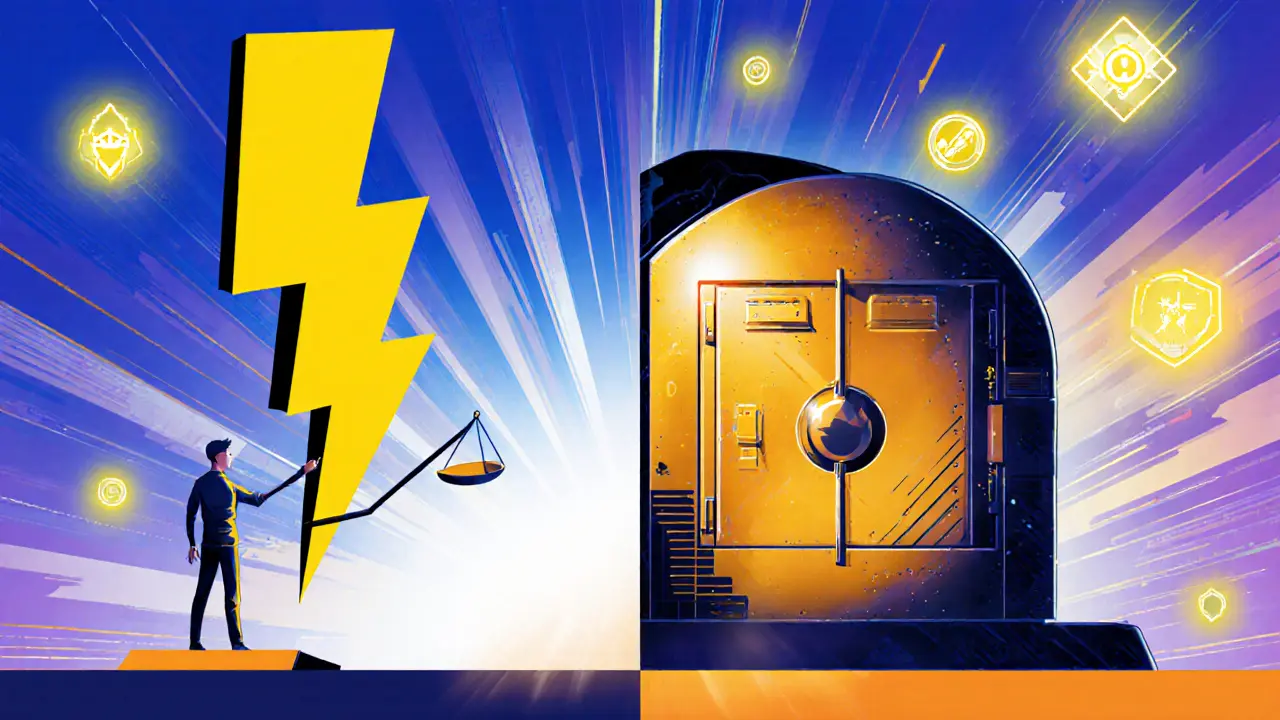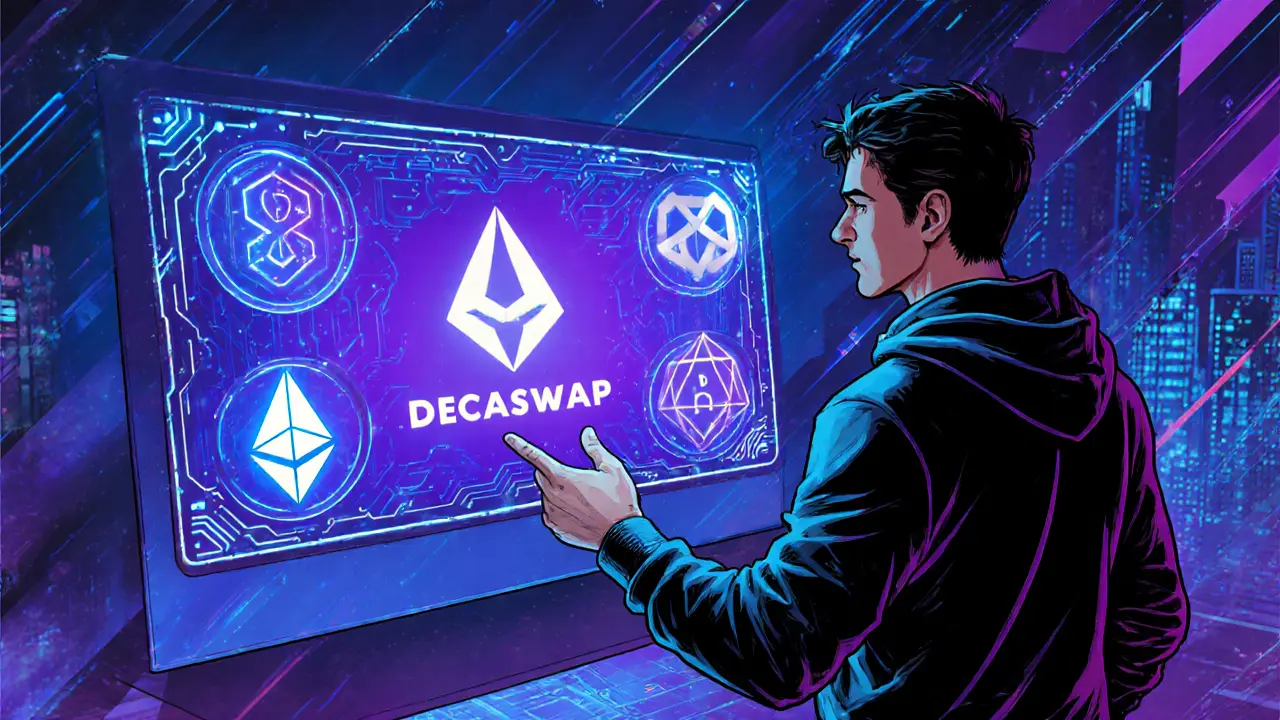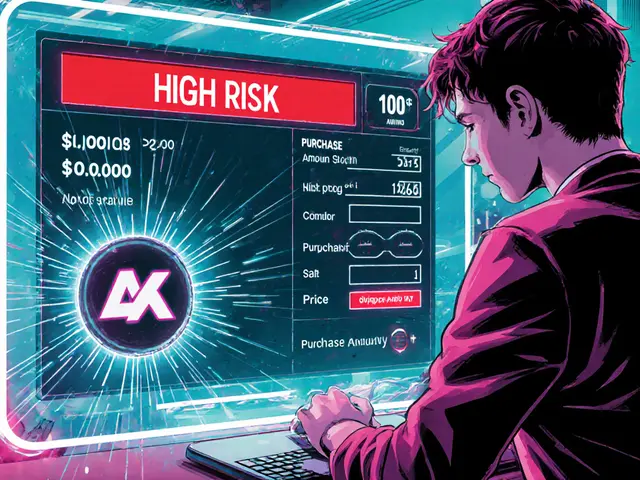Decaswap Crypto Exchange Review: Features, Fees, and How It Stacks Up
When a new decentralized platform pops up, traders instantly wonder if it’s worth their time or just another flash‑in‑the‑pan. Decaswap is marketed as a low‑fee, cross‑chain DEX that promises fast swaps and a community‑governed token model. This Decaswap review breaks down what the exchange actually delivers, where it falls short, and how it measures against the big players that dominate the market.
What is Decaswap?
Decaswap describes itself as a multi‑chain decentralized exchange built on Ethereum and Binance Smart Chain, leveraging automated market maker (AMM) pools to enable trust‑less token swaps. Launched in early 2025, the platform introduced a native governance token - DEXA - that grants holders voting rights on fee structures, new pair listings, and future roadmap items.
Core Features and How They Work
- Cross‑chain swapping: Users can move assets between Ethereum, BSC, and Polygon without leaving the interface. The bridge uses audited smart contracts that lock tokens on the source chain and mint wrapped equivalents on the destination.
- Dynamic fee model: Decaswap starts at a flat 0.15% fee on swaps, but the rate can be reduced to 0.05% for holders of at least 5,000 DEXA. Fee rebates are distributed automatically via on‑chain snapshots.
- Liquidity mining: Early liquidity providers earn DEXA rewards for supplying pairs like ETH/USDC, BNB/USDT, and the newer CRO/AVAX pool.
- Governance dashboard: A web‑based UI lets token holders propose and vote on changes. Proposals need a 10% quorum of total DEXA supply to pass.
- Security audits: The platform underwent two audits in 2025 - one by CertiK and another by PeckShield - both reporting no critical vulnerabilities.
User Experience (UX) Overview
The front‑end feels familiar to anyone who has used Uniswap or SushiSwap. The home page shows a swap widget, recent transaction feed, and quick links to “Add Liquidity” or “Stake DEXA.” Loading times are under two seconds on average, thanks to server‑side rendering and CDN caching.
One standout is the “Swap‑Shortcut” toggle that automatically suggests the cheapest route across supported chains. For example, swapping ETH to BUSD will first check whether a direct ETH/BUSD pool exists on BSC; if not, the system routes ETH → USDC (Ethereum) → USDC (BSC) → BUSD, still keeping total slippage under 0.3% in most cases.
Fees, Slippage, and Gas Costs
Fee structures are a primary decision factor for traders. Below is a snapshot comparing Decaswap’s fees with three leading DEXs:
| Exchange | Base Swap Fee | Liquidity (USD bn) | Average Slippage (0.5% trade) | Audit Status |
|---|---|---|---|---|
| Decaswap | 0.15% (0.05% for 5k+ DEXA holders) | 0.8 | 0.22% | CertiK & PeckShield - No critical issues |
| Uniswap | 0.30% | 5.2 | 0.35% | OpenGSN audit - No critical issues |
| SushiSwap | 0.25% | 2.1 | 0.28% | Trail of Bits - Minor warnings |
| PancakeSwap | 0.20% | 3.4 | 0.31% | PeckShield - No critical issues |
Decaswap’s fee advantage shines when you hold DEXA, but its overall liquidity is still modest compared with Uniswap’s deep pools. The lower liquidity can lead to higher price impact on large trades, so whales often split orders across multiple platforms.

Security Track Record
Security is non‑negotiable in the DeFi world. Decaswap’s two audits mentioned earlier cleared all critical findings and recommended minor gas‑optimization tweaks. The platform also implements a multi‑sig governance wallet for emergency fund withdrawals, mirroring the safety nets used by Curve Finance and dYdX.
Since launch, Decaswap has not suffered a major exploit, but it did experience a brief “sandwich attack” episode on its BNB/USDT pool in June 2025. The incident was mitigated within minutes, and the community voted to introduce a 0.1% anti‑bot tax on volatile pairs, effectively reducing future attack profitability.
Tokenomics of DEXA
Understanding the native token helps decide whether to lock it for fee rebates. DEXA has a total supply of 100 million, with 40% allocated to liquidity mining, 20% to the development fund, 15% to early investors, and 25% to the community treasury. Token vesting follows a six‑month cliff with monthly releases thereafter, discouraging sudden dump cycles.
Price action since the token’s October 2025 launch has been volatile: it peaked at $2.30 during the first listing on KuCoin, fell to $0.90 after a market correction, and settled around $1.45 by September 2025. Holding DEXA for fee discounts can be profitable if the token maintains its current trajectory, but traders should watch governance proposals that could affect token supply.
How Decaswap Stacks Up Against the Competition
Every DEX has a niche. Here’s a quick rundown of where Decaswap shines and where it lags:
- Low fees for token holders: Unique rebate model not seen on Uniswap or SushiSwap.
- Cross‑chain convenience: Direct bridge integration beats single‑chain rivals like Curve (Ethereum‑only) but trails multi‑chain aggregators like 1inch, which sources liquidity from dozens of DEXs.
- Liquidity depth: Still growing; larger pools on Uniswap and PancakeSwap provide better price stability for big trades.
- Community governance: More transparent than Balancer’s token‑weighted voting but less mature than SundaeSwap’s DAO structure.
- Security audits: Comparable to top players; the dual‑audit approach gives extra confidence.

Practical Checklist for Potential Users
- Confirm you have a compatible wallet (MetaMask, Trust Wallet, or Coinbase Wallet) that supports Ethereum, BSC, or Polygon.
- Bridge any tokens you want to trade into the appropriate network using Decaswap’s built‑in bridge.
- Check the DEXA balance in your wallet; holding 5,000 DEXA unlocks the 0.05% fee tier.
- Review the liquidity pool size for your desired pair - if it’s under $100 million, consider splitting the trade.
- Enable “Swap‑Shortcut” to automatically find the cheapest route across chains.
- Stake any earned DEXA in the governance dashboard to earn additional rewards and influence future updates.
Common Pitfalls and How to Avoid Them
- Underestimating gas fees: Swaps on Ethereum can cost $8-$12 during peak times; using BSC or Polygon reduces this dramatically.
- Ignoring slippage settings: Set a max slippage of 0.5% to avoid surprise price changes, especially on low‑liquidity pairs.
- Holding too little DEXA: If you’re below the 5k threshold, the fee rebate won’t apply, making other DEXs potentially cheaper for small trades.
- Neglecting governance votes: Active voters receive occasional “vote‑boost” rewards; missing them means losing out on extra DEXA.
Future Roadmap Outlook
Decaswap’s publicly shared roadmap (Q4 2025-2026) includes:
- Integration with Osmosis for deeper Cosmos‑based liquidity.
- Launch of a layer‑2 rollup on StarkNet to cut gas fees further.
- Introduction of synthetic assets (sUSD, sBTC) via a partnership with a reputable oracle provider.
- Expansion of the DEXA staking program to include NFT‑based boosts.
If the team delivers on these items, Decaswap could close the liquidity gap with larger DEXs and become a serious multi‑chain contender.
Bottom Line - Should You Use Decaswap?
If you’re already active on Ethereum or BSC and value lower fees plus cross‑chain swaps, Decaswap is worth a try. The platform’s audit pedigree and transparent governance add credibility, while the liquidity pool sizes suggest it’s best suited for medium‑size trades (up to $50k) rather than mega‑whale moves.
For high‑volume traders who need deep order books, sticking with Uniswap or PancakeSwap might still be the safer bet. However, early adopters who accumulate DEXA and participate in governance could reap fee discounts and reward incentives that make Decaswap an attractive side‑step.
Is Decaswap a centralized exchange?
No. Decaswap operates as a decentralized exchange (DEX) using automated market maker (AMM) smart contracts, so users retain custody of their assets at all times.
What chains does Decaswap support?
As of Q3 2025, Decaswap supports Ethereum, Binance Smart Chain, and Polygon, with a bridge that lets you move tokens between them without leaving the interface.
How do I get the fee rebate?
Hold at least 5,000 DEXA in your wallet. The platform automatically applies the 0.05% fee tier at checkout; there’s no extra claim step.
Is Decaswap safe from hacks?
The code has passed two independent audits (CertiK and PeckShield) with no critical vulnerabilities. While no system is 100% risk‑free, the multi‑sig governance wallet and regular bounty program add layers of protection.
Can I trade NFTs on Decaswap?
Not yet. The roadmap mentions an NFT‑boosted staking program for 2026, but the current version focuses solely on ERC‑20 and BEP‑20 tokens.






13 Comments
johnny garcia
October 23 2025In the evolving tapestry of decentralized finance, Decaswap represents a pivotal node where cross‑chain interoperability meets reduced fee architecture. 🌐💡
Andrew Smith
October 28 2025Indeed, the platform’s fee‑rebate mechanism could be a game‑changer for traders seeking cost efficiency, and the community‑governed token adds a layer of participatory appeal! 🚀
Ryan Comers
November 1 2025While some hail it as progressive, I maintain that the US‑centric liquidity paradigm still dominates, and any claim of true decentralization feels more like rhetoric than reality. 🇺🇸
Prerna Sahrawat
November 6 2025The Decaswap initiative, in its present incarnation, aspires to occupy a liminal space between the nascent cross‑chain architectures and the entrenched monolithic DEX ecosystems.
Such an ambition inevitably summons a plethora of epistemic considerations regarding liquidity provenance, fee elasticity, and governance legitimacy.
From a macroeconomic perspective, the platform’s modest 0.15 % baseline fee, attenuated to 0.05 % for token custodianship of five thousand DEXA units, ostensibly signals a calibrated incentive schema.
Nonetheless, the liquidity aggregates disclosed-mere 0.8 billion USD-remain dwarfed by the multi‑trillion‑dollar order books that characterize incumbents such as Uniswap.
Consequently, traders executing sizeable positions may confront adverse price impact, compelling them to fragment orders across ancillary venues.
The bridge mechanism, predicated upon audited smart contracts that immobilize source assets whilst minting wrapped equivalents, introduces an additional vector of systemic risk that warrants scrupulous monitoring.
Audit attestations by CertiK and PeckShield, albeit reassuring, cannot exonerate the protocol from emergent exploits that transpire post‑audit.
The brief sandwich‑attack episode on the BNB/USDT pool exemplifies the perpetual vulnerability inherent to liquidity pools operating under deterministic pricing algorithms.
In response, the community‑endorsed anti‑bot levy of 0.1 % reflects a governance agility that is commendably swift.
However, the tokenomics of DEXA, with forty percent earmarked for liquidity mining, engenders a potential inflationary pressure that could erode fee‑rebate benefits over time.
The vesting cadence, featuring a six‑month cliff followed by monthly disbursements, mitigates abrupt market saturations but does not obviate the specter of coordinated dump cycles.
Strategically, the roadmap’s envisaged integration with Osmosis and a StarkNet rollup portends a diversification of liquidity sources and a diminution of gas overhead.
Such expansions, if actualized, may ameliorate the current depth deficit and render Decaswap a more formidable multichain contender.
Nevertheless, the platform’s reliance on the DEXA token for fee reductions creates a quasi‑dual‑layered entry barrier that could alienate casual participants.
The ‘Swap‑Shortcut’ heuristic is an elegant abstraction, yet its efficacy remains contingent upon the underlying inter‑chain liquidity topology.
In sum, Decaswap embodies a compelling synthesis of low‑fee dynamics and governance empowerment, albeit tempered by nascent liquidity and token‑centric constraints that prudent traders must judiciously evaluate.
Joy Garcia
November 11 2025One must question whether the token‑centric rebate model subtly coerces users into speculative holding, thereby inflating DEXA’s price under the guise of utility-a classic DeFi moral hazard.
mike ballard
November 15 2025🚀🚧 Decaswap’s AMM architecture leverages cross‑chain bridge protocols and employs gas‑optimised swap routing, which aligns with the evolving DeFi stack and reduces friction for institutional on‑ramps.
Molly van der Schee
November 20 2025I understand the excitement around low fees, but newcomers should calibrate expectations, especially regarding bridge latency and potential slippage on thinner pools.
Erik Shear
November 25 2025The platform shows promise yet it must improve depth and mitigate sandwich attacks quickly.
Tom Glynn
November 30 2025Your point about rapid governance response is spot on; swift community action can indeed harden the protocol against exploits. 🙌
Johanna Hegewald
December 4 2025Decaswap is easy to use and the fee discounts work if you hold enough DEXA.
Benjamin Debrick
December 9 2025Indeed, the audit reports, while thorough, do not preclude future vulnerabilities; nevertheless, the dual‑audit approach, certified by both CertiK and PeckShield, provides a commendable layer of assurance, albeit one must remain vigilant, especially as the platform scales.
Anna Kammerer
December 14 2025Oh sure, because another token with a rebate is exactly what the market needed-sarcasm aside, the mechanics are straightforward.
Mike GLENN
December 19 2025The user experience benefits from the intuitive swap widget, which aggregates liquidity across chains, thereby simplifying cross‑chain transactions. However, the reliance on wrapped assets introduces an additional trust assumption that may deter risk‑averse participants. The slippage settings, though configurable, demand careful calibration to avoid unexpected price movement. In practice, many traders overlook this nuance, leading to suboptimal execution. The platform’s recent implementation of the ‘Swap‑Shortcut’ mitigates this to an extent, yet it is not a panacea. Consequently, a disciplined approach to order sizing and fee awareness remains paramount. Finally, the governance dashboard, while feature‑rich, could be more accessible to newcomers, perhaps through guided tutorials.